Comments?
For the basics, see
- Website & Privacy Policies
- How To Get Involved
- The Role of the Park
Search options:
Department Site Map
Custodians:
 News 2007
News 2007
Quick Page Table of Contents
Scanning...
News 2007
From the November 2007 newsletter
GEORGIE DONAIS’ TRIP to the Natural Building Colloquium in Texas:
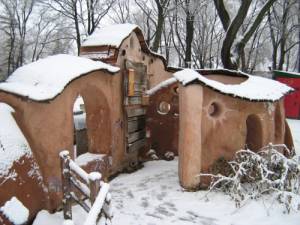
The Cob Courtyard in Winter
Dufferin Grove staff asked park cob builder Georgie Donais if she could show them her pictures tell stories of her visit to the Texas colloquium. So Georgie will do a show-and-tell at the rink house, on Wednesday , November 14, at 7:30pm.
From Georgie:
“I would like to sincerely thank the many people who came to the special fundraising supper in October, and CELOS, for sponsoring my trip to the colloquium. I spent ten days learning, building, laughing, planning, dreaming, scheming, singing, and dancing. And freezing. (I was not quite prepared to be camping in weather that reached as low as 32°F, as they say in Texas.)
I met and worked alongside some of the mentors whose books I’ve learned from: Kaki Hunter and Doni Kiffmeyer of Earthbagging fame; Elke Cole, cob builder in BC; Kiko Denzer, earth oven builder, writer, and artist; Sun Ray Kelly, Organic Architect (see some of his work at www.potkettleblack.com/natbild/sunray.html); Matts Myhrman and Judy Knox, two of the original straw bale builders; Coenraad and James from House Alive; Pete Fust, host of the original natural building colloquiums in the mid-nineties; Chris Magwood, author and strawbale builder from Ontario; and Joe Jenkins, author of the “Humanure Handbook” author and ace comedian (you’d have to be, I guess, to talk about that subject all the time).
Besides all the friendships and contacts I made, some other exciting things happened while I was there. A delegation made up of Mark Lakeman from City Repair in Portland, David Eisenberg of the Development Center for Appropriate Technology and Penny Livingston-Stark from the Permaculture Institute of Northern California met with Austin’s mayor to talk about how the city can enhance its already green objectives.
A representative from the Parks Department at Corpus Christie came to recruit people to work with them to get more natural materials and community involvement into that city’s parks. He was very interested in what we’ve been doing at Dufferin Grove Park, and may be inviting me down to work his department with other natural builders some time in the next year.
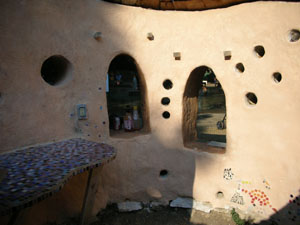
From the June 2007 newsletter
COB MAINTENANCE
Oregon earthen builder and sculptor Kiko Denzer www.handprintpress.com writes "The best way to "preserve" art is to create it, and re-create it, again and again." (Kiko's wonderful books are in the park's little research reference library -- if you want to have a look, ask the park staff.) The world over, earthen walls get seasonal repair and "sprucing up," each time becoming a little different. This year, Daniel Cayley first replaced a few missing cedar shingles. Then Heidrun Gabel-Koepff, a park friend and sculptor originally from Bremen, Germany, has been working on shingling the middle section.
Two weeks ago park staff discovered that someone had poured some kind of sticky grease down the cob sinks, which clogged all four sinks for a few days. Rec staff consulted Georgie, Sylvie and Simon (community cob builders) and tried a variety of home-made remedies (coca cola, vinegar, baking soda, salt…) none of which worked. So staff called city plumber Tom Feeney who sent Eugene and Ray who used a power snake to unclog the drains. A big thank you!
A week later, staff found the sinks were clogged once again, but this time with sand and leaves. With the purchase of some new tools of their own, the drains have been cleared. Staff ask park users to please use the sandpit hose for cleaning sandy hands to keep our cob sinks in good repair. Expert sign painter Jessica Moore is back in town from Montreal, just in time to make some signs to remind us of this request.
From the May 2007 newsletter
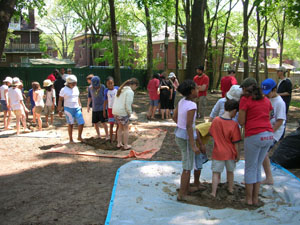
School field trips for cobbing in the park,
Wednesday May 23 to June 20.
From park staff Sarah Cormier:
“This is a one-of-a-kind, hands-on field trip where students take part in an earthen building workshop and lend a hand in the construction of the park’s cob bio-toilet. The foundation for the bio-toilet was completed last summer, and now it’s time to add the surrounding cob structure. Cob is a building material made by mixing clay, sand, and straw by foot, and forming it by hand into walls. This is a chance for students to contribute to the creation of a unique, permanent addition to the park. It is also a rare opportunity to add a fun practical component to discussions about the environment and recycling. Working with cob is a way to recycle, re-using waste materials like concrete and clay to create beautiful, useful structures.
“This is an ideal outing for grades one to eight, a remarkable chance to have fun, learn a lot, and help with a community building project. Cost is $5 per student, which includes cob workshop and pizza materials. The program is 1 ½ - 2 hours, and there are three slots available each day beginning at 10:30am, 12:00pm, and 12:30pm. Come get muddy and learn something new!” E-mail staff@dufferinpark.ca or call Amy Withers at 416 392-0913.
Read more about the school trip>>
posted May 17, 2007
COB COURTYARD SPRING REPAIRS
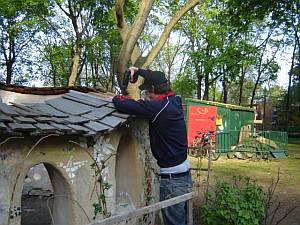
missing shingles put back on
Oregon earthen builder and sculptor Kiko Denzer www.handprintpress.com writes "The best way to "preserve" art is to create it, and re-create it, again and again." (Kiko's wonderful books are in the park's little research reference library -- if you want to have a look, ask the park staff.) The world over, earthen walls get seasonal repair and "sprucing up," each time becoming a little different. This year, Daniel Cayley first replaced a few missing cedar shingles.
Then Heidrun Gabel-Koepff, a park friend and sculptor originally from Bremen, Germany, shaved the unshingled middle section of the cob wall so that it could also accept shingles.
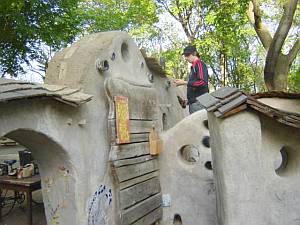
Top of cob wall shaved
Heidrun is also experimenting with different plaster mixes, to repair cracks from the winter. This winter, the cob plaster held up better than last, with much less of the loosening that was evident in sections last year. As soon as the weather warms up (plaster sticks best when applied in warm weather when the temperature never goes below 10 Celsius), Heidrun will try out her latest mixes.
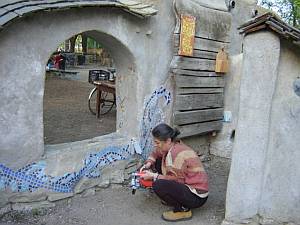
Heidrun checking out plaster
posted May 08, 2007
Green Toronto Award Finalist
Lead cob builder, Georgie Donais was a finalist this year in the Green Toronto Awards
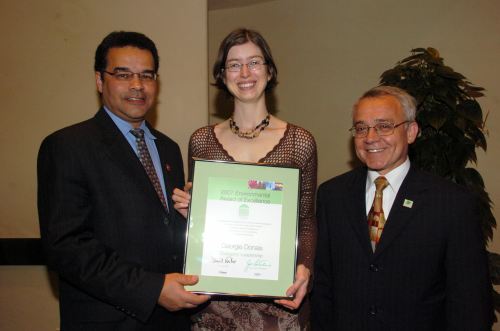
posted April 01, 2007
Quick Cob Figures - Benefits of Cob
Just how much, how many, and what go into (or don't go into) the making of the cob structures?? Here are a few interesting figures to give you an idea of some of the ways cob construction is environmentally and people friendly:
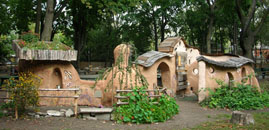
Cob Courtyard Wall
Volunteer Participation
Summer 2005: approx 500 volunteers
Materials diverted from landfill
Clay: 337.5 cubic feet
Concrete: 225 cubic feet
Bio-toilet/Earthen Building (cancelled in 2007)
Volunteer Participation
Summer 2006: approx 200 volunteers 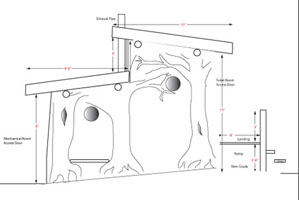 Summer 2007: project on hold
Summer 2007: project on hold
Summer 2008: approx 500 volunteers
Projected total: 700 volunteers
Projected total: 600 volunteers
Materials to be diverted from landfill
Clay: 477 cubic feet
Estimated reduction in conventional toilet uses per season:
Approx 6,900
Estimated water use avoided
(based on 6 litre flush): 41,400 litres
(based on 13 litre flush): 89,700 litres
Average: 65,550 litres
The Phoenix toilet model is rated to take up to 100 uses per day in the summer months. An average season would probably see about 6,900 uses of the facility. Taking this many flushes out of the conventional waste system saves approximately 65,550 litres of potable water from being flushed down the toilet. It also reduces:
|
-Additional water use during the sewage cleansing process; |
-Emissions from creating the energy; |
posted March 24, 2007
Cob in the Park Field Trip
Join us in Dufferin Grove Park for a one-of-a-kind, hands-on fieldtrip where students take part in an earthen building workshop and make their own pizzas at the park’s outdoor wood-fired bake oven. Come get muddy, learn something new, and eat a delicious lunch in the park at springtime! Read on for more details. For bookings and more information please contact park staff, Amy, at staff@dufferinpark.ca or 416-392-0913.
Schedule
Every Wednesday, May 23 – June 20, 2007.
The program is 1 ½ - 2 hours, and there are three slots available each day beginning at 10:30am, 12:00pm, and 12:30pm.
Ages
We welcome groups of any age, though grades one to eight might enjoy it most.
Part 1. Building with Cob
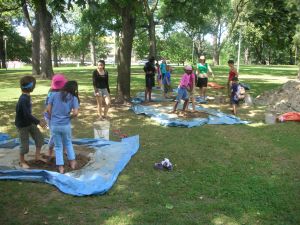
A day camp visit last summer
Georgie Donais, the driving force behind the community cob courtyard built two years ago, will lead students in an hour long cob building workshop where they will lend a hand in the construction of the park’s cob bio-toilet. The foundation and bio-toilet were completed last summer, and now it’s time to add the surrounding cob structure. Cob is a building material made by mixing clay, sand, and straw by foot, and forming it by hand into walls. This is a chance for students to contribute to the creation of a unique, permanent addition to the park.
It is also a rare opportunity to add an interesting practical component to discussions about the environment, sustainability, and recycling. Working with cob is a way to recycle, re-using waste materials like concrete and clay to create beautiful, useful structures. Students will gain first-hand knowledge of a natural building technique which takes less of a toll on the environment than popular construction methods. They are also encouraged to pick Georgie’s brain about the bio-toilet, an environmentally-friendly waste management alternative.
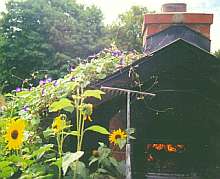
Part 2. Making Pizzas
After a quick wash-up at the sinks in the cob courtyard, it’s time for pizza-making. Park staff will have the bake oven hot and ready to go, and provide dough, sauce, cheese, and herbs from the community gardens – feel free to bring your own toppings!
Registration
Cost is $5 per student, which includes cob workshop and pizza materials.
Space is limited.
For bookings and more information please contact park staff, Amy, at staff@dufferinpark.ca or 414-392-0913.



 Printer friendly version
Printer friendly version